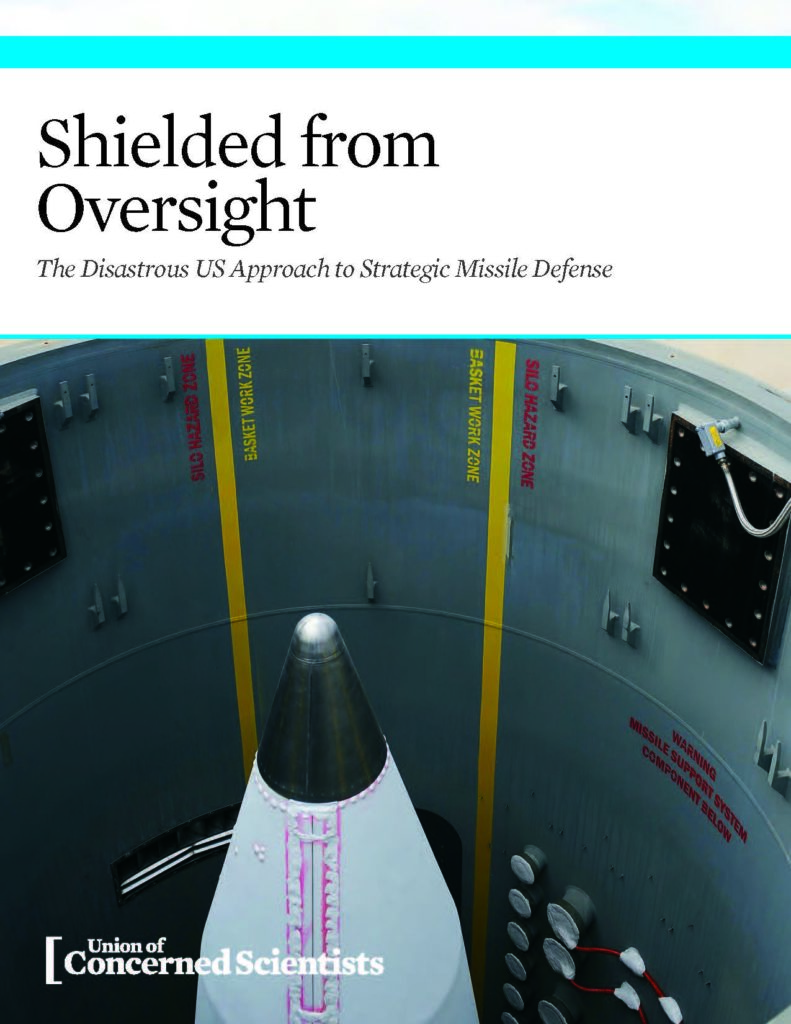Today we’re releasing a new report that looks at the US missile defense program nearly 15 years after the Bush administration began the push to deploy it. What we found was worse than we expected.
 Our analysis took us in a direction we didn’t necessarily expect. At the outset, we set out to assess the current state of the Ground-based Midcourse Defense (GMD) system. This is the missile defense system meant to defend the U.S. homeland from long-range nuclear armed missiles that countries such as North Korea or Iran might eventually field.
Our analysis took us in a direction we didn’t necessarily expect. At the outset, we set out to assess the current state of the Ground-based Midcourse Defense (GMD) system. This is the missile defense system meant to defend the U.S. homeland from long-range nuclear armed missiles that countries such as North Korea or Iran might eventually field.
UCS has long been involved in missile defense issues, so we were not surprised to find that the system is a mess. However what we found more interesting and, frankly, outrageous was how it got that way: an appalling lack of oversight and accountability for one of the most complex military systems ever built.
Exempted from standard oversight and accountability
In the wake of the September 11, 2001 terrorist attacks, the George W. Bush administration directed the Missile Defense Agency to field an initial homeland missile defense capability in two years, by 2004. That was an extremely ambitious timeline. To meet this unrealistic deadline, the administration exempted missile defense from many of the “fly before you buy” rules that major military systems normally must meet before they can be deployed. The fly before you buy oversight system—developed through years of experience—is meant to ensure that the system works as advertised and costs are under control.
Instead, missile defense equipment was rushed into the field. The figure below is produced from Missile Defense Agency’s own data, and shows that nearly every interceptor—the defensive missile that flies out to destroy the adversary’s incoming nuclear warhead—was fielded before ever having been successfully tested.

This figure shows when the 30 interceptors of the GMD system were fielded, following the 2002 Bush directive. The vertical axis shows the number of interceptors deployed. The interceptors come in two types, CE-I and CE-II; nearly all were deployed before the first successful intercept test of their design. The CE-I and CE-II interceptors have intercept test records of two successes out of four and one success out of three tries, respectively.
And today, the GMD system has still only been tested under conditions carefully scripted to ensure success—although it has nevertheless failed to destroy the test warheads two-thirds of the time since the 2004 deployment deadline. And its record is getting worse with time, not better.
Normally, equipment must undergo rigorous testing that shows it works in operational conditions before it can be moved to the field; missile defense is not required to do this, and so the system currently fields 30 interceptors—26 in Fort Greeley, Alaska and four in Vandenberg Air Force Base, California—that have not been shown to work.
Congress is making things worse
Congress, rather than reining the program in and insisting on accountability, contributes to the problem by pushing to significantly expand the system before fixing its problems or the process it’s using to build it.
It has added money to the budget to build an additional interceptor site for the GMD system, despite the fact that the Missile Defense Agency has not asked for a new site. In the fiscal year 2017 National Defense Authorization Act, Congress added both a provision to expand the scope and mandate of homeland missile defense, to potentially defend against the much larger and more sophisticated arsenals of Russia and China, and demands the Missile Defense Agency devise a plan for a space-based missile defense.
What’s more, insufficient oversight has not only allowed problematic equipment to be fielded, it serves to obscure the full extent of the problems. And so U.S. officials can and do regularly state that the system currently works to protect the U.S. when it has never demonstrated that capability.
That, in fact, can be a dangerous thing. Believing that the U.S. is better-protected from nuclear threats than it really is can lead decision makers to take more risks, or to not pursue diplomatic solutions as vigorously as they otherwise might.
Bottom line
We remain skeptical that an effective strategic missile defense system can be built, especially in light of the fact that an adversary can make defense yet more difficult by including decoys and other countermeasures on its missiles. But our main finding from this report is that if the US looks at the risks and benefits and sees strategic missile defense to be worth building, it must fundamentally change its approach. If the GMD system is to be part of addressing the ballistic missile threat, the administration must bring the GMD system under rigorous accountability and oversight.
The ongoing failure of Congress and the Pentagon to require rigor, and instead make unsubstantiated claims about the system’s effectiveness while continuing to provide billions of dollars in funding, is both cynical and a disservice to the public.
